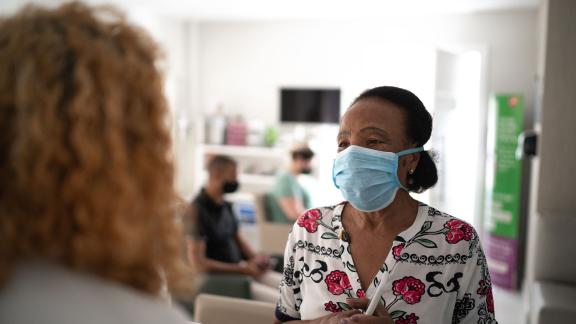Using digital to support integration: primary care and community services integration in Bexley during COVID-19

This case study describes how by developing a digital solution, Bexley Health Neighbourhood Care is meeting its COVID-19 challenges of tracking and looking after its patients and care home residents, its staff and the operation of GP practice sites.
About the organisation
Bexley Health Neighbourhood Care (BHNC) is a not-for-profit community interest company and GP federation supporting 22 GP practices in four PCNs, with a patient population of around 446k within South East London. BHNC in its current structure has been in place for just over 12 months and continues to grow and innovate in six areas: primary care and PCN support; community care; workforce development; infrastructure and IT; governance and quality; business development; and training and education.
The BHNC board is comprised of four elected voting directors who are all GPs. All 22 GP practices are members of the GP federation, which supports practices to secure quality services for patients through the delivery of the following objectives:
- Support Bexley GP practices to help deliver the best services for patients and meet the challenges of a changing NHS while improving patient outcomes through PCNs.
- Continuously improve the health and wellbeing of general practice in Bexley by sharing expertise, services and resources to support staff.
- Make a positive impact on the improvement of medical services and the quality of care in Bexley by working closely with the CCG, local NHS trusts, local providers and patient groups to improve the delivery of healthcare based on the needs of the population.
- Lead and improve the education of staff and patients in Bexley by working with the Bexley Training Hub for staff and the GP federation’s own training faculty for patients and staff.
- Look at local, national and global innovation to transform PCNs and introduce bespoke digital solutions to create efficiencies with the system.
Challenges
There were, and continue to be, two main challenges for BHNC during COVID-19:
1. How do we track and look after our patients/care home residents?
2. How do we track and look after our staff and the operation of GP practice sites?
This was an immediate COVID-19 challenge, but crucially while the ‘new normal’ continues to be defined, this is also a longer-term challenge as the NHS will never go back to pre-COVID ways of working. There is also the challenge of coordinating the wider multidisciplinary team (MDT) caring for patients/residents in a very agile way. Staff are increasingly working remotely and this will be the new normal, thanks to the use of digital technology.
What the organisation did
BHNC responded to COVID-19 by rapidly developing a digital solution to the two challenges above, with digital partners Appian, as well as wider social and community care partners.
This solution is an accelerator digital application designed to track the care of patients and care home residents. The functions in the development include workflows for triage, assessment, multi-agency plans and the delivery of care through tasks allocated to teams or individuals across the wider MDT.
It has the potential to support PCN service delivery in the long term, including the enhanced health in care homes service specification, as well as other specifications such as anticipatory care, personalised care, which were brought forward following the impact of COVID-19 in care homes. BHCN focused on building the key areas of the enhanced health in care homes service specification into the patient workflow process. The app is built according to specific ‘personas’ who have different levels of access to patient information, for example care homes admission/hospital discharge staff, social care, rapid response, community care and GPs. The vision is to provide the PCNs and wider MDT with a ‘helicopter view’ of all patients in the system, so care givers/teams can define the care pathway for each patient and create care plans to support the ongoing delivery of that care. The platform also supports the delivery being tracked live in real time once implemented fully.
Results and outcomes
The digital solution has the potential to enable the MDT to be very co-ordinated in the way it tracks the care of patients and care home residents. The initial feedback on the digital solution and targeted deployment is very positive. BHCN is currently at the start of a pilot to collaborate with local partners in care homes to live test and further develop the solution. The solution has interest across other boroughs in south east London and across England. These new collaborative partnerships led to a common set of objectives: to beat COVID-19 and digitally innovate to sustain the highest quality of care for patients. The live pilot results will be evaluated in September 2020. The new live pilot phase, as part of the enhanced health in care homes PCN service specifications, is being instated within six practices across four PCNs in Bexley with six care homes. In addition, Lambeth Federation is also considering a pilot of the solution.
BHNC is exploring some key initial connections to systems, for example My CMC (Co-ordinate My Care) for the advanced care plans to flow into the solution; care homes for the resident data and general practice (EMIS) for primary care information. The approach to the work now is to ask care homes colleagues and general practice what they need and where the pain points are in terms of both care co-ordination and delivery, but also the administration burden.
There is much work still to do in this vital area to support residents in care homes. The timetable set out by NHSEI in the NHS Long Term Plan expects rapid progress on building MDTs and digital enablers. By March next year all PCNs and MDTs are required to have co-designed and developed new ways of working, including digital solutions to meet the challenges. The development and leverage of BHNC’s digital solution is still to be proved at scale but the early signs are positive for staff and patients.
Overcoming obstacles and challenges
Taking a risk as a small organisation was the biggest challenge. BHNC is being helped by partners who share and support managing this risk. NHSEI, the Health Innovation Network and other bodies have connected BHNC with key people and organisations. NHSEI and the Time for Care Team are now supporting the process mapping for the project and part of the wider delivery team.
There are obviously obstacles in changing the way things are done and have been for many years. This shows itself in simple tasks where spreadsheets, emails and Word documents are used to co-ordinate information and care. This works at a level but does not do so efficiently when the scale of co-ordination and getting systems to talk to each other needs to happen in real time. The ethos of BHNC’s work is to have information input once and then shared with all other aspects of the care process and people where necessary. Just doing this releases clinical and administrative time that is reinvested in better quality, more joined-up care with the patient/resident at the centre.
Delivering a large-scale digital change management solution during a pandemic is and continues to be a huge challenge. BHNC continues to work hard with partners to ensure the longer-term benefits of embedding a new system can be achieved. There is a challenge to ensure successful culture change is earned. To meet this challenge, BHNC listens and learn with partners to build a new digital solution that is proven to make a difference to the work of care staff and patients/residents. It’s important to work with like-minded teams and individuals who want to trial something completely new and continuously improve without being put off by setbacks.



